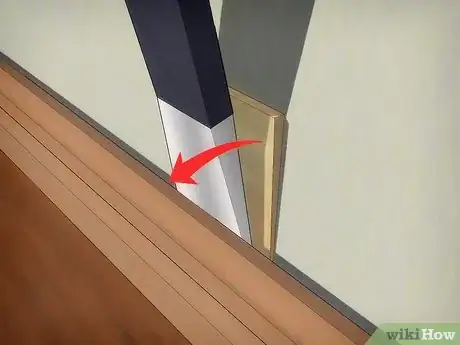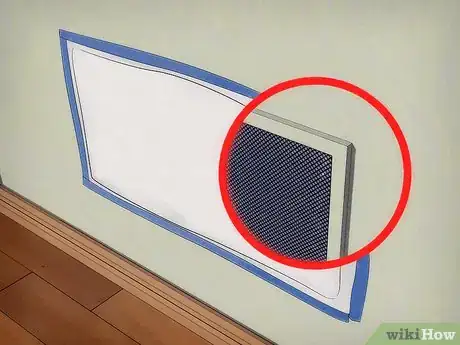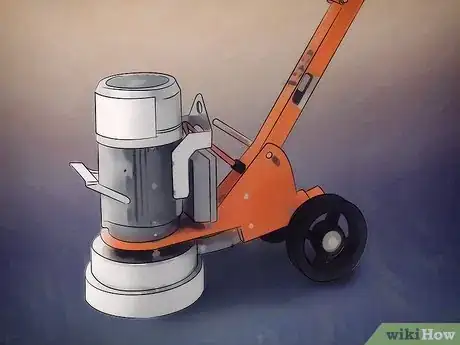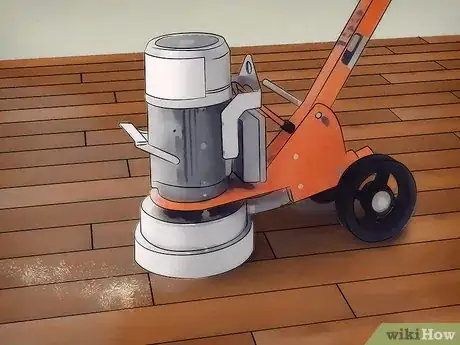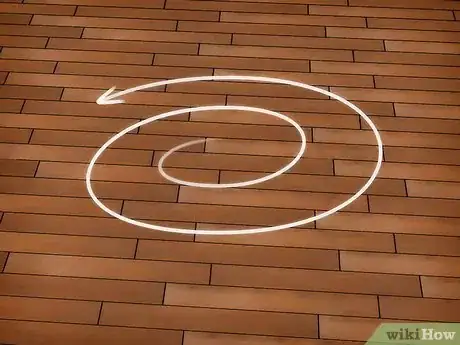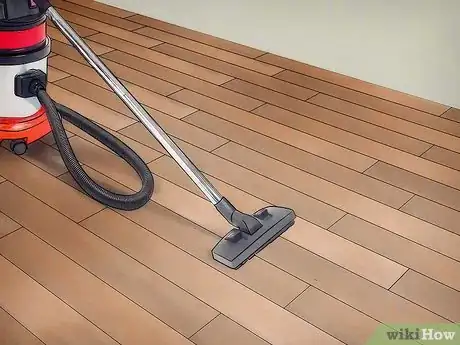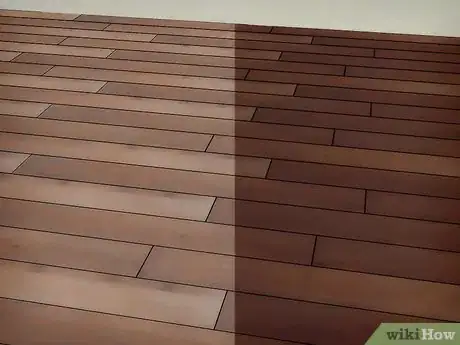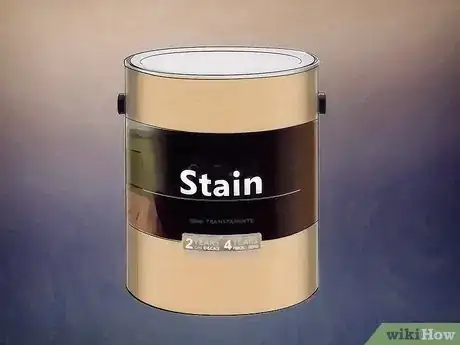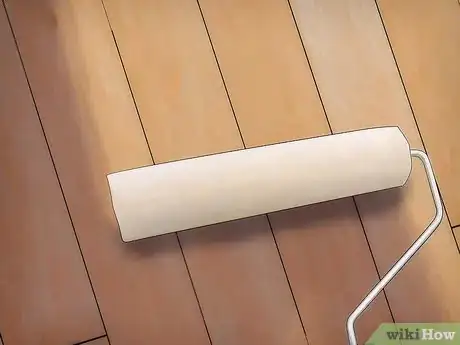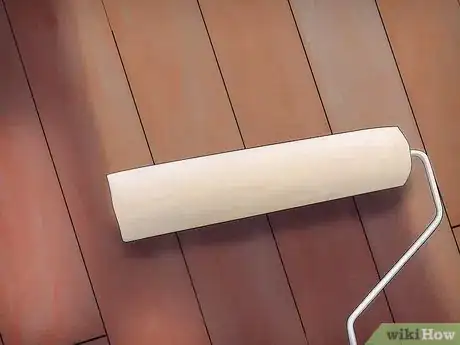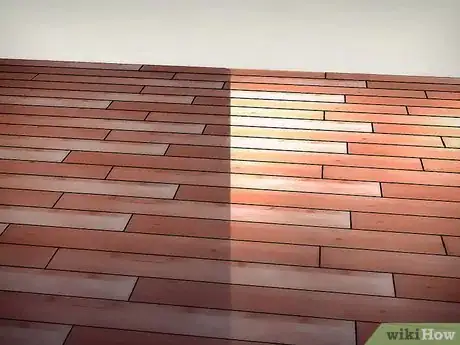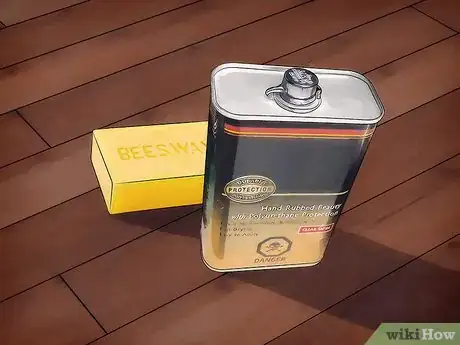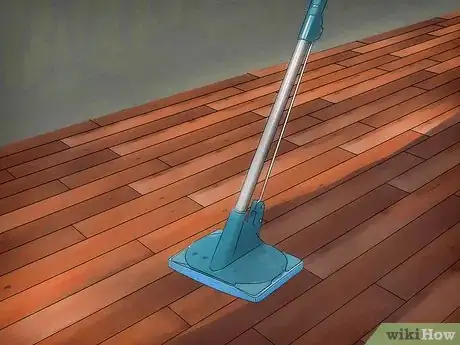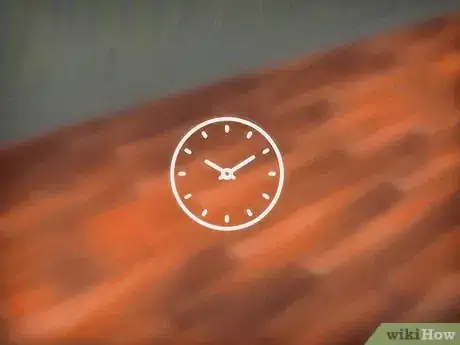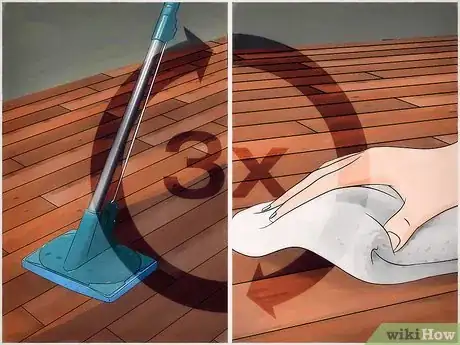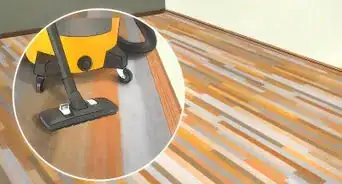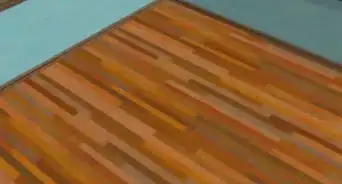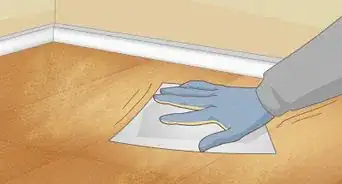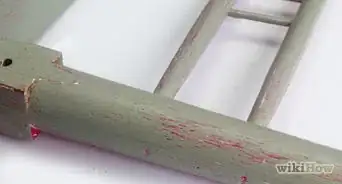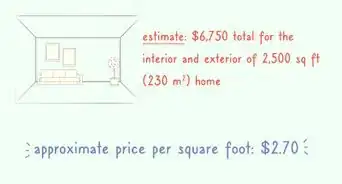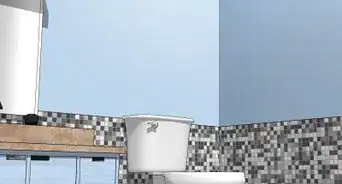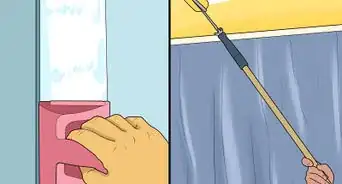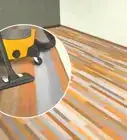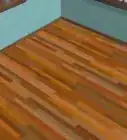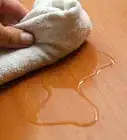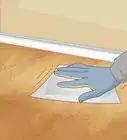This article was co-authored by Crystal Chadwick. Crystal Chadwick is a Licensed General Contractor and the Owner of Yin & Yang Construction out of Salt Lake City, Utah. With over 16 years of experience in the construction industry, she specializes in remodels, repairs, and handyman services. Crystal leads her team with vision and a detail-oriented approach, allowing them to provide quality work and design to their clients.
wikiHow marks an article as reader-approved once it receives enough positive feedback. In this case, 100% of readers who voted found the article helpful, earning it our reader-approved status.
This article has been viewed 146,278 times.
Hardwood floors tend to be resistant to soaking up liquid spills, owing to the closeness of the grain. This is a property that makes hardwood floors more durable than, for instance, a pine floor, but also makes them more difficult to finish. There are many finishes on the market; your choice depends on how exposed the floor is, how much traffic it will carry, and how dark you want your wood floor to stain.
Steps
Preparing the Area
-
1Prepare the area that is going to be finished. Make sure that the room is devoid of any furniture, window treatments and wall hangings. If the floor continues into a closet, make sure to empty it.[1]
- Be cautious not to drag furniture across wood floors. Heavy furniture may scuff the hardwood and leave marks.
-
2Remove trim using a pry bar. Insert a small piece of wood behind the pry bar to provide leverage, and to prevent damaging the trim pieces.Advertisement
-
3Protect the room from sawdust and stain fumes. Seal all of the openings–electrical outlets, vents, and light switches–with masking tape. Cover the light fixtures with trash bags, and secure them with masking tape. Separate the room from the rest of the house by taping the door shut or hanging plastic sheeting in the doorway.[2]
- You may find gaps or gouges in the wood which need to be filled. Apply wood putty according to the manufacturer's instructions. Allow it to dry thoroughly before proceeding with your finishing.
- You should also protect yourself from sawdust and stain fumes by wearing a respirator.
-
4Vacuum the floor thoroughly to remove any dust and debris. Any water spots where the wood has turned black can be treated by mixing a 50-50 solution of bleach and water to remove all or nearly all black spots.
Sanding the Floor
-
1Use an electric drum sander to prepare the floor.[3] [4]
- You can rent a drum sander from any equipment rental facility. Consider renting a floor sander from a local hardware store; consider borrowing a sander from a friend or neighbor.
- Get the 180-grit pads (180 grits per inch), if you have a choice. If you are re-finishing old floors, start with the 80 grit pads, and be thorough.
-
2Tilt the machine back when you start it. Gently lower it into contact with the floor once it's begun to spin.
- Start with 20- to 60-grit sandpaper. You will end the project with sandpaper between 80- and 120-grit.[5]
- Practice sanding an area that won't be visible when the furniture is replaced. This will avoid making any noticeable errors.
-
3Begin sanding in the middle of the floor, working outward the edges. Sand along the grain of the wood, and overlap each pass by an inch (2.54cm) or two (5.08cm) so that you don't miss a spot. The grain is the natural flow of the wood – the fibrous lines that hold the wood together. Planks are usually cut so that the grain lines flow down the length of the board.
- Sanding by machine requires that the machine sands with the grain of the wood. Sanding on the bias will destroy the wood's appearance, and you may find yourself shopping for carpet.
- Finish up the edges with a handheld power sander. Use a smaller, handheld sander to tidy up the areas that the electric sander might have missed--especially the edges of the room, or any part of the floor that's at all obstructed.
-
4Repeat this whole process as many times as necessary, moving on through progressively finer grits of sandpaper.[6] Most hardwood floors can be sanded up to four times. Clean the floor thoroughly before beginning the next round of sanding: vacuum the dust, and wipe down the floor with a dry cloth.
-
5When you're done sanding, make sure that the wood is clean. Vacuum the floor, then wipe it with a dry cloth. If you're going to stain your floor, you'll need to make sure that there's no remaining sawdust that can obstruct the stain.[7]
Staining the Floor
-
1Decide whether or not you want to stain your floor. Wood stain can highlight the natural hues of the wood or it can give your floor a unique, colorful twist. If you are already happy with the color of the hardwood, you do not need to stain the floor. Move on to waxing and buffing the floor or apply a clear polyurethane finish.[8]
-
2Choose a stain. When picking a stain brand, value quality over quantity; don't be afraid to spend 40 or 50 dollars on a gallon. When choosing a color, keep in mind that the stain will look very different over an entire room than it did on the sample chart. Understand that the color will soak into the wood and fade slightly. Pick a finish that goes well with the room, and pick one that you're willing to live with for a long time.
- Depending on the brand, you will need 1–2 gallons (3.8–7.6 L) of stain for an average floor. If you are attempting this for the first time, get a water-based stain: it is much easier to work with.
- Get a staining pad head with a detachable extension. The cheapest way is to get the replaceable pads. If you're using a semi-transparent stain, be sure to get the soft white fiber for staining, as the paint-specific pads will apply all but the solid color stain unevenly.
- A darker stain color can help cover up stains like dog urine that have seeped into the wood and won't come out with sanding.
-
3Apply a durable floor sealant to the hardwood prior to staining it. This will prevent uneven coverage. Ask at your local hardware store or flooring specialist; they should be able to direct you to the right product.[9]
-
4Stain the floor generously using a brush, a rag or a roller. After 10-15 minutes, use a rag to wipe away any excess stain. Pour as much stain as you will need to work with into a bucket and stir it thoroughly. This will also help to ensure even coverage. don't let the layer get too thick; you want a thin, even layer that will dry smoothly.[10]
- Apply a small amount of stain to a small test area. The color may vary considerably from the display at the store.
- Be sure to stir the stain regularly during the application process.
- Avoid leaving a stain or water spill on the wood: it will stain and rot if left unattended.
-
5Add as many additional coats as you need to achieve your desired result. Allow ample drying time between each coat. Water-based stains need to dry for 2-6 hours, and oil-based stains need to dry for 6-10 hours. As it dries, you will have a better idea of whether you want another coat. You will probably need at least two coats of stain to reach the exact shade that you chose.
- The more coats you add, the darker the finish will be.[11]
-
6Consider using a polyurethane clear-coat. You can get a softer finish for a natural-looking protective barrier, or a semi-gloss finish to make your new floor really shine. Use the same process to apply. Use a paint roller to evenly spread the polyurethane across the floor. Let it dry completely. Consider rolling out an extra coat for added protection and shine. If you do not want to use polyurethane, you can choose to wax and buff the floor instead.[12]
- Try to stick to the base you used for the floor: if you chose a water-based stain, then be sure to use a water-based polyurethane clear-coat.
- Once you've applied the polyurethane coat, do not walk on the floor for 24 hours (or as long as the urethane packaging says that it needs to dry). If you walk on the floor before the coat is completely dry, you might smudge the gloss and leave unsightly blemishes across your hardwood.
- Do not steam-mop the floor for at least a month after finishing.
Waxing and Buffing the Floor
-
1Wax your floor to seal the wood, and buff it to remove excess wax. This can be tough, time-consuming work, but it will make your hardwood floor last much longer. You can wax and buff your floor before you have stained it, after you have stained it, and whether or not you have stained it. If you have stained the floor, make sure that the stain has completely dried before you try to apply wax.[13]
- Wax and buff your floor three or four times to build up plenty of protective layers. Set aside at least a full day for this process, as it can become very time-intensive.
- Make sure to clear the floor of all furniture, clutter, and dust before you begin. Consider mopping the floor or wiping it clean with a damp towel beforehand.
-
2Choose the right wax. If your floor has never been treated, you can use any wax or finish product that is labeled "hardwood". Polyurethane and beeswax are popular choices that you can find in most hardwood stores. Each product will appear slightly different, so do your research and determine which look you want. You can wax a floor whether or not you stain it.
- If the floor finished, check whether it is dirty. If the existing top layer is scratched, but not dirty, you can simply apply a new coating of wax on top of the old layer. If the finished floor is dirty, you will need to thoroughly buff the floor before you apply a new coating.
- Wax soaks into the wood, so it is hard to fully remove. This makes the floor unsuitable for a synthetic finish, unless you hire a professional to strip the wax fully. You can easily apply new wax after you strip the floor.
-
3Wax the floor. Fill a bucket with floor wax, then use a damp sponge mop or flat wax applicator mop to spread the wax over the floor. Don't wax yourself into a corner: start along the far wall of each room and work your way toward the door. Spread the wax over one section of the floor at a time, and make sure to get an even coat. Apply three or four thin coats, or as many as the wax product packaging recommends. Let each coat of wax dry completely before you lay down another coat.[14]
- If your first layer is too thick, the whole process could fail to set properly. Be careful not to drip excess wax onto the floor. Make sure that the mop is damp, but not soaked.
- Don't apply too many coats. Stop if the wax starts turning yellow.
- Wash all tools immediately when you are done waxing. If you let the wax dry, it will be difficult or nearly impossible to remove.
-
4Wait for the wax to dry completely. This should take about half an hour, but could take longer in areas with high humidity. After ten minutes of natural drying, you can point a fan into the room to make it dry faster. Do not point the fan directly at the waxed floor, or it might interfere with the adhesive. Read the label of your floor wax for a more accurate estimate of the drying time.
- Make sure that you've got an even coating, and that you allow it to "set" before you move on to buffing. Make sure that your wax needs to be buffed. Many waxes are no-buff, and they will remain glossy with no further effort.
- Avoid stepping or placing anything onto the final coat for at least eight hours. Shut the door of the waxed room so that children, pets, and dirt cannot enter.
-
5Buff the floor. Buffing means removing the wax from the floor by wiping it with a clean towel. It is best to buff the floor by hand, but you can also tie the towel around a dry mop head so that you don't have to be on your hands and knees. Get a clean, dry cloth and get to work, moving with the grain of the wood. Rub the wood hard enough that you can see the wax coming off onto the cloth. Make sure that the wax is completely dry before you begin to buff.
- Go over the entire floor three or four times, making sure to get as much wax as possible clear of the wood. Your goal here is to ensure that there's no excess wax on the floor, and that the wax that's there is sealing the wood.
- You can buff a floor whether or not you have stained it. If you have finished a floor by staining it, buffing ensures that you won't have air bubbles in the finish, and thus that the floor will last longer.
-
6Repeat. Once you're sure this is done, repeat the entire process, reapplying the wax and buffing it off at at least three times. Repetition is important, as it builds up resilient layers of wax to protect your floor. Repeated waxing and buffing may seem like a lot of unnecessary work, but it will make your hardwood floor last much longer.
Expert Q&A
-
QuestionIs it difficult to sand hardwood floors?
 Crystal ChadwickCrystal Chadwick is a Licensed General Contractor and the Owner of Yin & Yang Construction out of Salt Lake City, Utah. With over 16 years of experience in the construction industry, she specializes in remodels, repairs, and handyman services. Crystal leads her team with vision and a detail-oriented approach, allowing them to provide quality work and design to their clients.
Crystal ChadwickCrystal Chadwick is a Licensed General Contractor and the Owner of Yin & Yang Construction out of Salt Lake City, Utah. With over 16 years of experience in the construction industry, she specializes in remodels, repairs, and handyman services. Crystal leads her team with vision and a detail-oriented approach, allowing them to provide quality work and design to their clients.
Licensed General Contractor Not necessarily, but it can pretty time-consuming. You'll have to go over your floors with heavy-grit sandpaper first, and then again with lighter-grit paper.
Not necessarily, but it can pretty time-consuming. You'll have to go over your floors with heavy-grit sandpaper first, and then again with lighter-grit paper. -
QuestionHow do you stain a floor with rags?
 Crystal ChadwickCrystal Chadwick is a Licensed General Contractor and the Owner of Yin & Yang Construction out of Salt Lake City, Utah. With over 16 years of experience in the construction industry, she specializes in remodels, repairs, and handyman services. Crystal leads her team with vision and a detail-oriented approach, allowing them to provide quality work and design to their clients.
Crystal ChadwickCrystal Chadwick is a Licensed General Contractor and the Owner of Yin & Yang Construction out of Salt Lake City, Utah. With over 16 years of experience in the construction industry, she specializes in remodels, repairs, and handyman services. Crystal leads her team with vision and a detail-oriented approach, allowing them to provide quality work and design to their clients.
Licensed General Contractor Grab a rag, put on some gloves, and get on your hands and knees. Then, apply the stain in swiping motions, following the grain of the wood as you go. Try to walk yourself out the room so you aren't surrounded by wet stain.
Grab a rag, put on some gloves, and get on your hands and knees. Then, apply the stain in swiping motions, following the grain of the wood as you go. Try to walk yourself out the room so you aren't surrounded by wet stain. -
QuestionCan you apply multiple coats of stain?
 Crystal ChadwickCrystal Chadwick is a Licensed General Contractor and the Owner of Yin & Yang Construction out of Salt Lake City, Utah. With over 16 years of experience in the construction industry, she specializes in remodels, repairs, and handyman services. Crystal leads her team with vision and a detail-oriented approach, allowing them to provide quality work and design to their clients.
Crystal ChadwickCrystal Chadwick is a Licensed General Contractor and the Owner of Yin & Yang Construction out of Salt Lake City, Utah. With over 16 years of experience in the construction industry, she specializes in remodels, repairs, and handyman services. Crystal leads her team with vision and a detail-oriented approach, allowing them to provide quality work and design to their clients.
Licensed General Contractor You can, but you don't have to. One coat of stain should be enough for your floor, though you can apply extra if you'd like a darker finish.
You can, but you don't have to. One coat of stain should be enough for your floor, though you can apply extra if you'd like a darker finish.
References
- ↑ https://www.apartmenttherapy.com/how-to-refinish-hardwood-floor-107774
- ↑ https://www.apartmenttherapy.com/how-to-refinish-hardwood-floor-107774
- ↑ https://www.homedepot.com/c/ah/how-to-refinish-hardwood-floors/9ba683603be9fa5395fab901a1d66e5
- ↑ Crystal Chadwick. Licensed General Contractor. Expert Interview. 16 March 2021.
- ↑ Crystal Chadwick. Licensed General Contractor. Expert Interview. 16 March 2021.
- ↑ Crystal Chadwick. Licensed General Contractor. Expert Interview. 16 March 2021.
- ↑ Crystal Chadwick. Licensed General Contractor. Expert Interview. 16 March 2021.
- ↑ https://www.doityourself.com/stry/hardwoodfloorstain
- ↑ https://www.doityourself.com/stry/hardwoodfloorstain
- ↑ https://www.homedepot.com/c/ah/how-to-refinish-hardwood-floors/9ba683603be9fa5395fab901a1d66e5
- ↑ Crystal Chadwick. Licensed General Contractor. Expert Interview. 16 March 2021.
- ↑ https://www.dummies.com/home-garden/flooring/how-to-refinish-a-hardwood-floor/
- ↑ https://www.bhg.com/homekeeping/house-cleaning/surface/how-to-wax-hardwood-floors/
- ↑ https://www.bhg.com/homekeeping/house-cleaning/surface/how-to-wax-hardwood-floors/
About This Article
To finish hardwood floors, start by removing any furniture and trim in the room and vacuuming the floors so there isn't any dust or debris on them. Then, use an electric drum sander to sand the floors several times so they're ready for the stain and wax. Next, apply a floor sealant and stain to the floors using a brush or roller. Once the stain is dry, buff the floors with hardwood wax several times, which will help them last longer. To learn how to choose a stain and wax for hardwood floors, read on!

